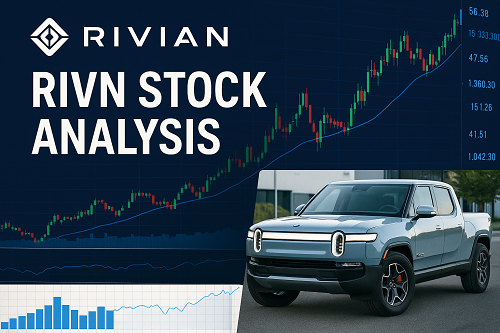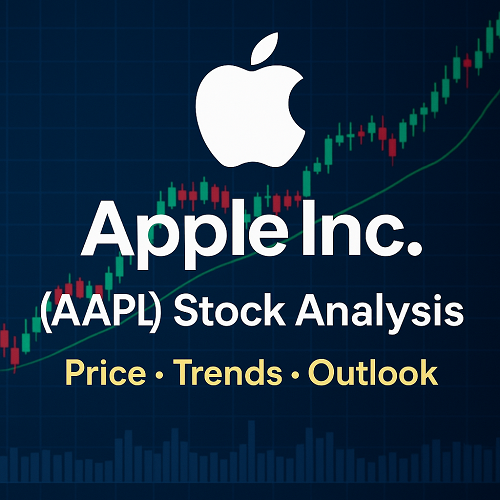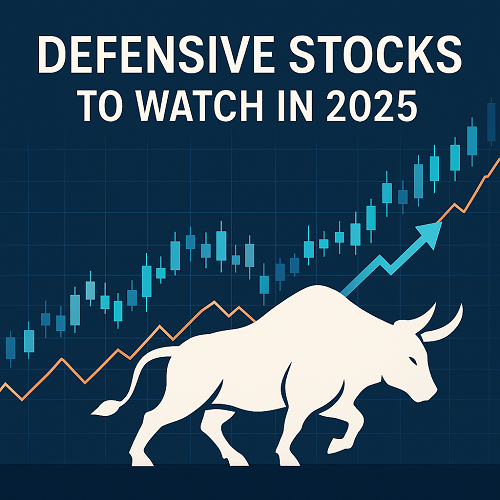Rivian Automotive, Inc. (NASDAQ: RIVN) is one of the most watched electric vehicle (EV) manufacturers in the U.S., blending consumer-EV pickup/SUVs with commercial delivery vans. While the company has seen significant hype and investment, it also faces profound execution, financial and competitive challenges.
This article presents an in-depth analysis of Rivian—from its business model and industry context, through recent financials, production updates, strategic levers, risks, valuation and trading implications—designed for both investors and active traders. The goal is to go well beyond a simple quote and provide actionable insight.
Key takeaways up front:
- Rivian is transitioning from high-end EV niche (R1T, R1S) into more volume models (R2), supported by major strategic partners.
- The company remains unprofitable, with heavy cash burn, and must scale production and improve margins.
- Industry dynamics (EV subsidies, supply chain, legacy automaker competition) create both opportunity and risk.
- For traders, RIVN offers strong volatility and potential reward—but risk is elevated.
- From a valuation standpoint, the stock must be judged more on execution and future growth than on current earnings or traditional multiples.
Company Overview & Context
Origins & Business Model
Rivian was founded in 2009, and its business has evolved into three main pillars:
- Consumer EVs: The R1 T pickup and R1 S SUV built on the company’s “skateboard” platform.
- Commercial/Delivery Vans: The Rivian EDV (electric delivery van) aimed at fleet/third-party customers.
- Platform & Technology Licensing: Rivian has announced partnerships (notably with Volkswagen Group) to license its EV architecture and software.
Headquartered in Irvine, California, Rivian also operates a manufacturing facility in Normal, Illinois.
Market Positioning
Unlike some EV peers that focus on mass-market sedans or crossovers, Rivian differentiated via premium electric trucks and SUVs—a space less crowded. Its vehicles target more adventurous/outdoor lifestyle users. At the same time, the commercial van business opens large addressable markets (fleet/e-commerce delivery).
Strategic Partnerships
A notable milestone: Volkswagen’s investment (~US$1 billion in 2025, part of a larger multi-year technology joint venture) signals external validation of Rivian’s platform.
Industry & Competitive Landscape
The EV/automotive industry is undergoing rapid change. Key themes for Rivian:
- Subsidies & regulation: EV tax credits, tariff regimes and local incentives matter. Rivian has cited concerns about elimination of credits and tariff risks.
- Competition: Legacy automakers (such as Ford Motor Company with the F-150 Lightning, General Motors with the Silverado EV) are accelerating their EV truck programs. Tesla remains dominant with the Cybertruck looming.
- Scale & cost structure: Achieving profitability in EV manufacturing typically demands high volume, strong margin per vehicle and efficient supply chain. Scaling remains a major hurdle for younger EV OEMs.
- Supply-chain/production bottlenecks: Component shortages (e.g., semiconductors, battery raw materials) and manufacturing ramp risk remain relevant.
- EV adoption growth vs. headwinds: Though EV penetration is rising, growth is slowing in some markets (e.g., U.S. EV growth was only ~1.5% in early 2025).
For Rivian, navigating this landscape will require execution on production ramp, cost reductions (especially for next-gen R2 platform), and effective differentiation.
Recent Financial Performance & Key Metrics
Here’s a summary of Rivian’s recent performance and financial health.
Revenue & Losses
- For Q2 2025 (reported August 5): Revenue reached ~US$1.3 billion, up ~12.5% year-over-year, beating expectations (~US$1.28 billion) though still losing money.
- For Q1 2025: Revenue of US$1.24 billion (-28.5% YoY) and net loss of about –US$545 million.
- Despite improvements, the company remains unprofitable with a heavy negative net-margin and high burn.
Key Ratios & Metrics
- Price/Book: ~3.1x as of Sept 2025.
- Debt/Equity: ~0.73.
- Return on Equity: –54.4 %.
- Growth rates: Revenue grew ~31.9% in Q4 2024 vs Q4 2023, but net loss remained large (-US$743 m for Q4 2024).
- Analysts view fundamentals as “deteriorated” short-term due to losses and execution risk.
Production/Delivery Figures
- Q3 2025 production: ~10,720 vehicles. Deliveries: ~13,201 vehicles (delivery > production due to inventory draw).
- 2025 full-year delivery guidance (narrowed) to 41,500-43,500 vehicles.
These numbers underscore that while Rivian is making progress (e.g., achieving gross profit in Q4 2024). there remain significant execution demands and financial risks ahead.
Operational & Production Update
Manufacturing & Ramp
Rivian’s manufacturing base is anchored in Normal, Illinois. The company also has plans for a new factory in Georgia (Stanton Springs) targeted to begin production of volume models in 2028.
Vehicle Platforms & Next-Gen Models
- R1 Platform: Current high-end models (R1T, R1S) built on skate board architecture.
- R2 Platform: Next-gen model aimed at lower price point and higher volume, significantly reducing bill-of-materials cost (targeted around half of R1).
- Progress: Design validation ongoing, cost reductions targeted. However, constraints in production volume at the existing plant raise concern: Q3 2025 production of only 10,720 vehicles suggests the operational ceiling may be near ~42,000 annualized units.
Inventory & Deliveries
Q3 delivery exceeding production by 23% (13,201 vs 10,720) indicates Rivian drew down inventory to boost deliveries, which may not be sustainable without production ramp-up.
Cash & Funding
Rivian continues to burn cash while scaling. A key positive: Volkswagen’s equity investment of US$1 billion (June 30, 2025) at an effective price of US$19.42 per share.
Nevertheless, scale, margin improvement, and delivery growth remain critical to reaching cash-flow breakeven.
Strategic Drivers & Growth Catalysts
Rivian offers several strategic levers which could drive value if executed well.
Cost Reduction & Platform Scale
The R2 platform with a target significantly lower bill-of-materials cost presents a strong upside if implemented successfully. Scale will drive fixed cost absorption and margin improvement.
Commercial Van Business (EDV)
The fleet/EV van segment is under-penetrated and large. Rivian’s early entry is a differentiator. Success here can provide recurring revenue, strong partnerships (e.g., with Amazon.com, Inc.) and a more stable business than consumer cyclical demand.
Strategic Partnership with Volkswagen
VW’s investment and joint-venture architecture licensing offer validation and potential for scale via other OEMs. This may generate licensing and software revenue streams (higher margin).
EV Infrastructure & Ecosystem
Rivian’s ecosystem (charging network, software updates, service footprint) may strengthen brand and differentiate from newcomers. As EV adoption grows, the ability to service and support may be key.
Market Transition & EV Tailwinds
Even as EV growth slows a bit in the U.S., the shift to electric across trucking, fleet delivery and off-road niches remains a long-term tailwind—favoring companies already scaled into these segments.
Risks & Headwinds
No deep dive would be complete without candid enumeration of the risks.
Scale & Execution Risk
The most significant risk: inability to ramp production and improve margins fast enough. The fact that deliveries in Q3 exceeded production (via inventory draw) signals potential bottlenecks.
Financial Burn & Cash Runway
With large ongoing losses, Rivian must either reach cash-flow positivity or secure additional funding. Any delay in ramp or cost reduction creates funding risk.
Competition
Legacy automakers are accelerating EV truck/van programs (Ford, GM, etc). The competitive moat may be narrower than perceived. Pricing pressures may emerge.
Regulatory & Incentive Uncertainty
Changes in EV tax credits, tariffs, supply chain disruptions and component shortages (batteries, semis) pose macro risks. Rivian management has flagged these explicitly.
Market Sentiment & Valuation Pressure
Given its “loss-making startup” status, the stock remains vulnerable to negative news, delivery misses or cost over-runs. Sentiment shifts can have outsized impact.
Developments in R2 / Georgia Plant Timing
Delays or cost overruns in the next-generation platform (R2) or Georgia factory could meaningfully impact long-term potential. The plant in Georgia, estimated for production in 2028, is a large bet.
Valuation & Trading Considerations
Valuation Snapshot
- Price/Book ~3.1x (Sept 2025) but with negative earnings.
- Traditional multiples (P/E, EV/EBITDA) are not meaningful given negative profitability.
- Analysts at MarketScreener recently called the short-term fundamental configuration “deteriorated.”
- Investors therefore must focus on future execution, not trailing earnings.
Relative Valuation
Compared to younger EV peers, Rivian carries both upside (via commercial van + trucks) and risk. The licensing/JV model with VW may offer “option value” beyond the core vehicle business. A DCF model would hinge on ramp rates, gross margin evolution and cash flow break-even.
Trading Considerations
For active traders:
- RIVN is volatile: high beta (~1.84) and large interest from retail/liquid markets.
- Key upcoming catalysts: quarterly earnings, delivery/production updates, R2 announcements, VW/JV progress, macro EV news (tariffs/incentives).
- Support/resistance: Since the company is heavily tied to sentiment, gap-alerts on delivery/margin news may present trading setups.
Risk/Reward Profile
- Reward: If Rivian can ramp production significantly (say >80k units by 2026), improve margins and monetize licensing, the stock could re-rate substantially.
- Risk: Delays in production, margin pressure, or a broader EV market pullback could cause sharp deterioration in investor confidence.
Technical / Trading Analysis
For those looking at RIVN from a trading or position-sizing standpoint, consider these factors:
- Liquidity & Volume: RIVN exhibits heavy trading volume and open interest in options.
- Volatility profile: Given its startup-EV nature, implied volatilities are elevated—options strategies (e.g., premium selling, straddles) may be viable for sophisticated traders.
- Catalyst-driven trading: A quarterly release, production update, or announcement (e.g., R2 timing) often triggers strong price moves.
- Chart levels: Watch for price consolidation zones, breakout above 20-day/50-day moving averages, or breakdowns under key support. Use stop-loss discipline given execution risk.
- Risk management: Given the structural risk, traders should size positions accordingly and consider hedging strategies (e.g., options).
Outlook: Near-Term (12-18 months) & Long-Term (3-5 years)
Near-Term (12-18 months)
- Key milestone: Q4 2025 production ramp to meet the narrowed guidance of ~41,500-43,500 vehicles. Execution here will drive sentiment.
- Margin improvement: Investors will closely review cost per vehicle, gross margin trends, and van business growth.
- Licensing/JV progress: Updates on the Volkswagen deal or other OEM partnerships may serve as upside surprises.
- Macro/Electric vehicle incentives: Any positive regulatory changes (EV credits, tariffs easing) may act as a tailwind.
Long-Term (3-5 years)
- Scaling of R2 platform (lower-cost model) with higher volume and lower unit costs.
- Commercial van business maturity—fleet contracts and recurring revenue may stabilize earnings.
- Georgia plant (from ~2028) potential to significantly scale manufacturing capacity (200k+ vehicles).
- Path toward profitability: If Rivian can hit meaningful gross margins and reduce cash burn, the stock may re-rate from a speculative growth status to a sustainable auto manufacturer.
Conclusion & Key Takeaways
Rivian presents a compelling but high-risk investment trade. On the positive side, it has differentiated product lines (trucks, vans), key partnerships (Volkswagen), and meaningful growth levers (R2 platform). On the other hand, the financial and execution hurdles are substantial—scaling manufacturing, reducing costs, delivering on ambitious guidance and fighting fierce competition.
Key takeaways for investors and traders:
- Execution matters more than ever: The next few quarters are critical.
- Valuation should be judged on future potential not current financials.
- Trading RIVN involves elevated risk but also elevated reward—appropriate only if risk is managed.
- Long-term upside exists if Rivian scales successfully, but delays or mis-execution could lead to steep downside.
Appendix: Selected Metrics & Calendar
- Q2 2025 revenue: US$1.3 billion (+12.5% YoY)
- Price/Book ratio: ~3.1x (Sept 2025)
- Production Q3 2025: ~10,720 vehicles; Deliveries Q3: ~13,201 vehicles
- 2025 delivery guidance (narrowed): 41,500-43,500 vehicles





 XAUT-USD
XAUT-USD  AMD
AMD  MARA
MARA  SHOP
SHOP  BULL
BULL  CL=F
CL=F